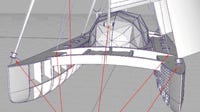Message in a bottle
The plastic bottle has become somewhat of a symbol of today’s mass consumption, and the low recycling rates, especially in the U.S., have turned landfills and oceanic gyres into bottle graveyards. But one adventurous environmentalist is out to prove that recycling PET can be not only eco-friendly, but also seaworthy.
April 23, 2009
The plastic bottle has become somewhat of a symbol of today’s mass consumption, and the low recycling rates, especially in the U.S., have turned landfills and oceanic gyres into bottle graveyards. But one adventurous environmentalist is out to prove that recycling PET can be not only eco-friendly, but also seaworthy.
|
Inspired by Thor Heyerdal’s historic 1947 expedition in which the Kontiki, a balsa wood replica of an ancient Inca raft, sailed across the Pacific, an organization called Adventure Ecology, created by British banking heir David de Rothschild in 2005, is building a 60-ft catamaran out of plastic bottles and recycled waste products. The Plastiki will sail approximately 11,000 miles over three months, traveling from San Francisco, CA to Sydney, Australia through the Eastern Pacific Garbage patch that’s twice the size of Texas, with de Rothschild and a crew of scientists and sailors gathering data along the way.
The expedition’s aim is to help “beat waste” using plastic, which is said to account for approximately 90% of all debris floating in the oceans, in a new, creative way. The zero-emissions boat will incorporate several innovative self-sustaining life support systems, including a hybrid trailing turbine electricity generation and propulsion system. “When you think that plastic bottles are 100% recyclable and yet only 20% are actually recycled, there is a lot of work to be done in that area,” says de Roths¬child. “A lasting legacy of the Plastiki will be its capacity to shift public thinking and perception from plastics as the enemy to how plastic can become part of the solution.”
Aside from using approximately 12,000 recycled PET bottles containing 12g of dry ice each to ensure their integrity and topped with a special ratchet-style cap, the structural skeleton of the boat, as well as the hull skeleton, cross beams, and cabin shell, are made from self-reinforcing (sr) PET. Developed by Comfil ApS (Gjern, Denmark), the srPET uses PET fibers with two different melting temperatures to create panels and structural components. The 392°F fibers melt and consolidate around the 464°F fibers, creating a strong matrix without the need for a secondary material like glass or carbon.
“The resulting PET composite panels not only stood up to the pressure tests, but are also uniquely recyclable, fitting wholly into the cradle-to-cradle philosophy, meaning it can continuously be up-cycled and repurposed for other uses,” says de Rothschild.
And what will happen after the Plastiki (fingers crossed) arrives safely in the Sydney harbor? The entire vessel will be broken up, and each element will be recycled or reused. The cabin is designed to be reused as part of a touring educational display, and the solar sculpture has been designed to function as a postapplication educational pod. —[email protected]
WEB EXTRA
View a YouTube video about the Plastiki expedition.
About the Author(s)
You May Also Like





